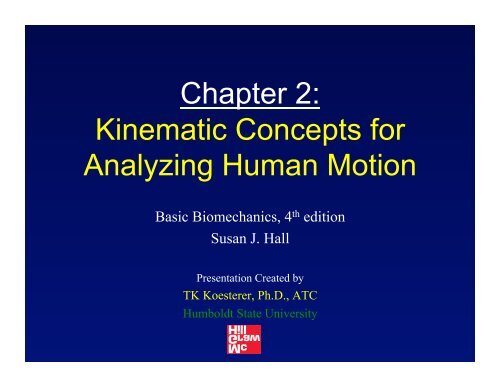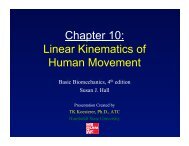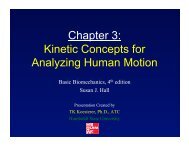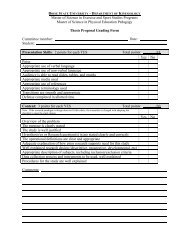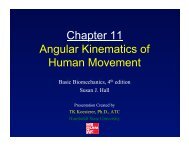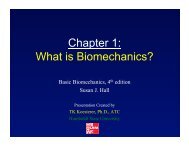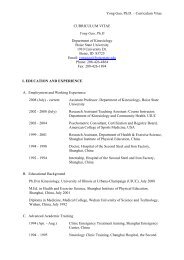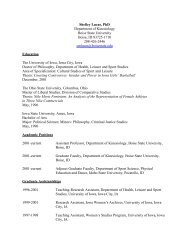Chapter 2: Kinematic Concepts for Analyzing Human Motion
Chapter 2: Kinematic Concepts for Analyzing Human Motion
Chapter 2: Kinematic Concepts for Analyzing Human Motion
Create successful ePaper yourself
Turn your PDF publications into a flip-book with our unique Google optimized e-Paper software.
<strong>Chapter</strong> 2:<br />
<strong>Kinematic</strong> <strong>Concepts</strong> <strong>for</strong><br />
<strong>Analyzing</strong> <strong>Human</strong> <strong>Motion</strong><br />
Basic Biomechanics, 4 th edition<br />
Susan J. Hall<br />
Presentation Created by<br />
TK Koesterer, Ph.D., ATC<br />
Humboldt State University
Objectives<br />
• Identify & describe reference positions,<br />
planes, and axes associated with the human<br />
body<br />
• Provide examples of linear, angular, &<br />
general <strong>for</strong>ms of motion<br />
• Define & appropriately use directional terms &<br />
joint movement terminology<br />
• Explain how to plan & conduct an effective<br />
qualitative human movement analysis<br />
• Identify & describe uses of available<br />
instrumentation <strong>for</strong> measuring kinematics
Forms of <strong>Motion</strong><br />
• Most human movement is general motion<br />
– A complex combination of<br />
• Linear and<br />
• Angular motion components
Forms of <strong>Motion</strong><br />
• Linear <strong>Motion</strong><br />
– May also be thought of as motion along a<br />
line that may be straight or curved, with all<br />
parts of the body moving in the same<br />
direction at the same speed, also known as<br />
translatory motion, or translation.<br />
• Rectilinear – along a straight line<br />
• Curvilinear – along a curved line
Forms of <strong>Motion</strong><br />
• Angular motion – involving rotation around a<br />
central line or point<br />
• Axis of rotation – imaginary line perpendicular<br />
to the plane of rotation and passing through<br />
the center of rotation
General <strong>Motion</strong><br />
• A combination of translation and<br />
rotation<br />
• Most human movement activities are<br />
categorized as general motion
2-2
Mechanical Systems<br />
• Be<strong>for</strong>e determining the nature of a<br />
movement, the mechanical system of<br />
interest must be defined.<br />
• System – a body or group of bodies<br />
whose motion is being analyzed
Standard Reference Terminology<br />
Anatomical Reference Position<br />
• Erect standing position with all body<br />
parts, including the palms of the hands,<br />
facing <strong>for</strong>ward; considered the starting<br />
position <strong>for</strong> body segment movements
Standard Reference Terminology<br />
Directional Terms<br />
• Superior<br />
• Inferior<br />
• Anterior<br />
• Posterior<br />
• Medial<br />
• Lateral<br />
• Proximal<br />
• Distal<br />
• Superficial<br />
• Deep
Standard Reference Terminology<br />
Anatomical Reference Planes<br />
• Cardinal planes – 3 imaginary perpendicular<br />
reference planes that divide the body in half<br />
by mass<br />
– Sagittal plane<br />
– Frontal plane<br />
– Transverse plane
Standard Reference Terminology<br />
Anatomical Reference Axes<br />
• An imaginary axis of rotation that passes<br />
through a joint to which it is attached<br />
– Mediolateral or frontal axis<br />
– Anterioposterior or sagittal axis<br />
– Longitudinal axis
2-5
Joint Movement Terminology<br />
• In anatomical position, all body segments are<br />
considered to be positioned at zero degrees.<br />
– Sagittal Plane Movements<br />
– Frontal Plane Movements<br />
– Transverse Plane Movements<br />
• Other Movements
2-6<br />
Sagittal plane movements
2-8<br />
Frontal Plane Movements
2-13<br />
Transverse Plane Movements
2-16<br />
Other Movements
2-19
Spatial Reference Systems<br />
• Used to standardize the measurements taken<br />
Cartesian Coordinate system<br />
• Movements primarily in a single direction, or<br />
planar, can be analyzed using a twodimensional<br />
Cartesian<br />
– X (horizontal) direction<br />
– Y (vertical) direction<br />
• 3-dimensional by adding a z-axis
Cartesian Coordinate System
Qualitative Analysis<br />
of <strong>Human</strong> Movement<br />
• Requires knowledge of the specific<br />
biomechanical purpose of the movement and<br />
the ability to detect the causes of errors<br />
• Qualitative refers to a description of quality<br />
without the use of numbers.
Prerequisite Knowledge<br />
<strong>for</strong> a Qualitative Analysis<br />
• <strong>Kinematic</strong>s<br />
• Per<strong>for</strong>mance outcome<br />
Analysts should be able to distinguish the cause<br />
of a problem from symptoms of the problem<br />
or an unrelated movement idiosyncrasy<br />
Experience in per<strong>for</strong>ming a motor skill does not<br />
necessarily translate to proficiency in<br />
analyzing the skill.
Planning a Qualitative Analysis<br />
1. What are major questions to be answered<br />
2. Determine the optimal perspective(s)<br />
3. Analyst’s viewing distance<br />
4. Number trial or executions<br />
5. Per<strong>for</strong>mer’s attire<br />
6. Nature of surrounding equipment<br />
7. Visual observation or video camera
Conducting a Qualitative Analysis<br />
• Continuous process of;<br />
– <strong>for</strong>mulating an analysis<br />
– collecting additional observations<br />
– <strong>for</strong>mulating an updated analysis<br />
• Detecting biomechanical errors<br />
• Characteristics of the per<strong>for</strong>mer<br />
• Other factors that can affect per<strong>for</strong>mance<br />
• Auditory in<strong>for</strong>mation<br />
• Feedback from the Per<strong>for</strong>mer<br />
• Observation skill
2-21
Tools <strong>for</strong> Measuring<br />
<strong>Kinematic</strong> Quantities<br />
• Cinematography & Videography<br />
– Standard video 30 pictures per second<br />
– Higher rates available<br />
– Clarity of images<br />
– Number of cameras to capture in<strong>for</strong>mation<br />
– Computer-linked equipment – digitizing
Measuring <strong>Kinematic</strong><br />
Quantities<br />
• Other Movement Monitoring Systems<br />
– Real-time tracking of LEDs<br />
– Computer-linked cameras track targets<br />
• Other Assessment Tools<br />
– Goniometer or Electrogoniometer<br />
– Photocells, light beams, and timers<br />
– Accelerometer
Summary<br />
• Teachers of physical activities, clinicians &<br />
coaches all routinely per<strong>for</strong>m qualitative<br />
analyses to assess, correct, or improve<br />
human movements<br />
• Both knowledge of the specific biomechanical<br />
purpose of the movement and careful<br />
preplanning are necessary <strong>for</strong> an effective<br />
qualitative analysis
The End


